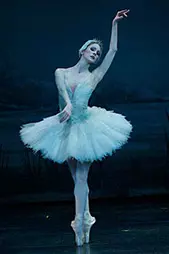- Home
- Patient Stories
- Tanya Strautmann - Hip Labral Tear
Tanya Strautmann - Hip Labral Tear
 In her 12 years with the St. Louis Ballet company — during which time she danced many lead roles and rose to international acclaim — principal ballerina Tanya Strautmann had missed only one day of class and performing. So when hip pain forced her to take two days off in the Spring of 2008, she knew she had crossed the threshold from what she calls “good pain” into “bad pain.”
In her 12 years with the St. Louis Ballet company — during which time she danced many lead roles and rose to international acclaim — principal ballerina Tanya Strautmann had missed only one day of class and performing. So when hip pain forced her to take two days off in the Spring of 2008, she knew she had crossed the threshold from what she calls “good pain” into “bad pain.”
“Dancers always have aches, but as I tried to push through, I eventually knew that something was not right.” After the two days off, she returned to class and “couldn’t do anything,” she says.
Visits to several doctors were unproductive, primarily, she believes, because many physicians can’t fully appreciate the movement required of dancers. “A long-distance runner’s knee might be the most challenging case most doctors see,” but a much wider range of graceful movement is required of a ballerina, and treating a dancer “takes a special awareness,” she says.
Then Strautmann recalled a lecture she had heard by Devyani Hunt, MD, and her colleagues in the Medical Program for Performing Artists group at Washington University School of Medicine’s Department of Orthopaedic Surgery. Hunt, assistant professor of orthopaedic surgery and a specialist in physical and rehabilitative medicine, also is a dancer. “She understands a dancer’s needs and speaks the language,” Strautmann says, “so when I say ‘developpe,’(a movement in which the working leg is drawn up to the knee of the supporting leg, then smoothly out into the air) she knows precisely the motion I’m describing.”
After X-rays ruled out arthritis and revealed that no bone had been fractured, Hunt suspected that Strautmann may have suffered a hip labral tear, an injury in which the ring of protective cartilage around the outside rim of the hip socket is damaged. Pain and limited range of motion are common symptoms of a labral tear, and athletes and dancers who engage in repetitive twisting or pivoting motions often are affected.
A torn labrum can be repaired or removed via arthroscopic surgery, but Hunt and her colleagues adopt a conservative philosophy of treatment. Strautmann also was uncomfortable with the idea: “After surgery, it can be hard or even impossible to attain the same level of physical capability,” she says, and she was committed to returning to her passion for dance.
So doctor and patient agreed to proceed with conservative measures and start with physical therapy. She was referred to another member of the performing arts group, Lynnette Khoo-Summers, DPT who was also a dancer. Khoo-Summers, instructor in physical therapy, customized a home exercise program of specific exercises designed to decrease irritation of the labrum. Like all Washington University physical therapists, Khoo-Summers practices Movement System Impairment Theory, a comprehensive approach that analyzes how muscles work and seeks balance among them, making certain that they work together rather than just focusing on one injured muscle. When the three met again, improvement was significant, and together they determined that the labrum would not require surgery.
Six physical therapy visits over the next eight weeks guided Strautmann’s continuing recovery, but the road back to professional dancing was long. “It was a severe injury, and it took me five months to begin real dancing again,” Strautmann says. So much of her muscle memory had been lost that she started over with Khoo-Summers at the barre with a 10-minute session, relearning a demi-plie — the first exercise a dancer studies. Whenever a problem occurred, Strautmann met with Dr. Hunt to diagnose her injury and Khoo-Summers to devise a technique for overcoming it.
Preparing recently to dance the lead role in Cinderella, Strautmann is back to full health and capability but scheduled a pre-performance visit with her medical team to take inventory and to review such details as the fit of her toe shoes. “A dancer uses every muscle and always is dealing with small issues. The best thing has been to have dancers as doctors. They understand,” she says.
Strautmann says that although the time off was hard to accept, particularly because her passion is to always improve, it nonetheless turned out to be for the best. “It forced a re-evaluation of my technique. Something was not right; I was overusing one muscle, which led to this problem. I gained from the injury.”
(photo courtesy of Saint Louis Ballet: “Allegro Brillante” photo by Gigi Weaver)
More Info: